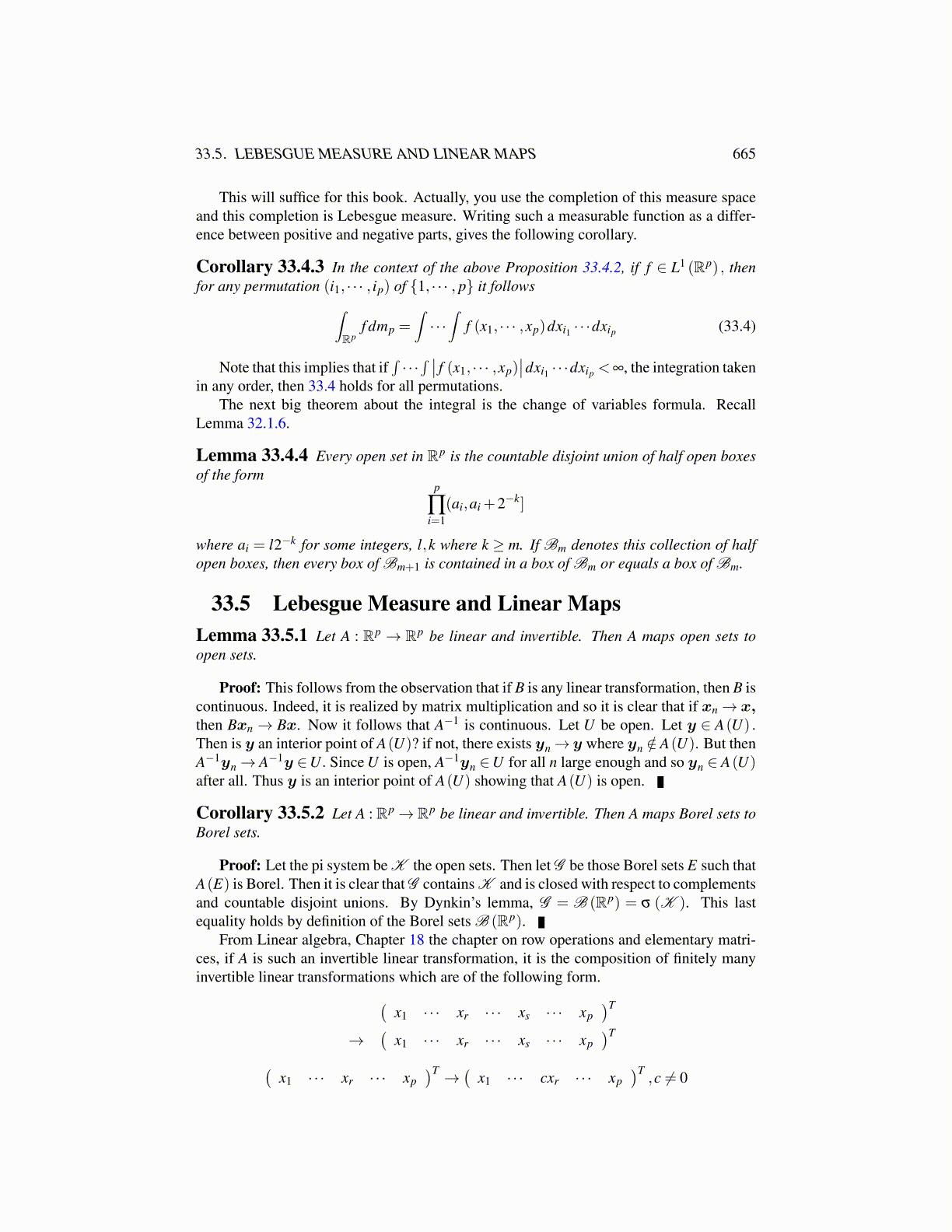
33.6. CHANGE OF VARIABLES FOR NONLINEAR MAPS 665
has the same properties as f and so, using the same argument with U and V switching rolesand replacing h with h−1, ∫
Uf (h(x)) |det(Dh(x))|dmp
≤∫
Vf(h(h−1 (y)
))∣∣det(Dh(h−1 (y)
))∣∣ ∣∣det(Dh−1 (y)
)∣∣dmp =∫
Vf (y)dmp
by the chain rule. This with 33.9 proves the lemma.The Lebesgue integral is defined for nonnegative functions and then you break up an
arbitrary function into positive and negative parts. Thus the most convenient theoremsinvolve nonnegative functions which do not involve assumptions of uniform continuity andsuch things. The next corollary gives such a result. This will remove assumptions that U,Vare bounded and the need for larger open sets on which h,h−1 are defined and C1.
Corollary 33.6.2 Let U be an open set in Rp and let h be a one to one C1 functionsuch that h(U) = V and |detDh(x)| ̸= 0 for all x. Let f be continuous and nonnegativedefined on V. Then ∫
Vf (y)dmp =
∫U
f (h(x)) |det(Dh(x))|dmp
Proof: Let Uk ≡ (−k,k)p ∩{x ∈U : dist
(x,UC
)> 1
k
}. Thus Uk ⊆Uk+1 for all k and
Uk is closed and bounded, hence compact. The inverse function theorem 24.0.6 impliesVk ≡ h(Uk) is open and h−1 is C1 on Vk. Also f is uniformly continuous on Uk hence onUk as well. It follows that∫
VXh(Uk) (y) f (y)dmp =
∫U
XUk (x) f (h(x)) |det(Dh(x))|dmp
Now use the monotone convergence theorem and let k → ∞.It is easy to generalize this corollary to the case where f is nonnegative and only Borel
meaurable. Let R = ∏pi=1 (ai,bi) , a open rectangle. Then let gk (x) ≡ ∏
pi=1 gk
i (xi) wheregk
i (t) ≥ 0, is continuous, piecewise linear, equals 0 off (ai,bi) and 1 on[ai +
1k ,bi − 1
k
].
Thus limk→∞ gk (x) = XR (x) and gk (x)≤ gk+1 (x) for all k. Therefore, apply the mono-tone convergence theorem to obtain∫
UXR (h(x)) |det(Dh(x))|dmp = lim
k→∞
∫U
gk (h(x)) |det(Dh(x))|dmp
= limk→∞
∫h(U)
gk (y)dmp =∫h(U)
XR (y)dmp
Now let K be the pi system of open rectangles. Thus σ (K ) = B (Rp). Let Rk ≡∏
pi=1 (−k,k)
G ≡{
E ∈ B (Rp) :∫
UXE∩Rk (h(x)) |det(Dh(x))|dmp =
∫h(U)
XE∩Rk (y)dmp
}Then it is routine to verify that G is closed with respect to countable disjoint unions andcomplements. The assertion about disjoint unions is obvious. Consider the one aboutcomplements. Say E ∈ G . Then
B∫h(U)
XE∩Rk (y)dmp +∫h(U)
XEC∩Rk(y)dmp =
∫h(U)
XRk (y)dmp